A pick-up-and-deliver economy game where players act as wealthy merchants using gondolas to gain political power
90-120 minutes
Designer: Andrei Novac, Dávid Turczi
Artist: Bartlomiej Roczniak
Publisher: Braincrack Games
Venice, the city, has some of the most well known and iconic imagery of any city in Italy. When thinking of Venice, most of us immediately picture the canals filled with gondolas navigated by skilled gondoliers.
In Venice, the board game, players navigate their gondolas through the city’s canals delivering goods and activating various buildings. We were so excited for game number 2 in Braincrack Games Eurocity Trilogy. We had a lot of fun with Ragusa (check out last year’s review HERE) and have been looking forward to playing another Dávid Turczi design (Anachrony is forever a favorite of ours). We have to admit, we were a little nervous to play this at 2 player, since pick up and deliver games often are best with more players.
Read on to see what we thought!
Note: While we were Kickstarter backers for Venice, Braincrack Games generously provided us with a review copy of the first game in the series, Ragusa. We have also played and will be reviewing the upcoming third game, Florence.
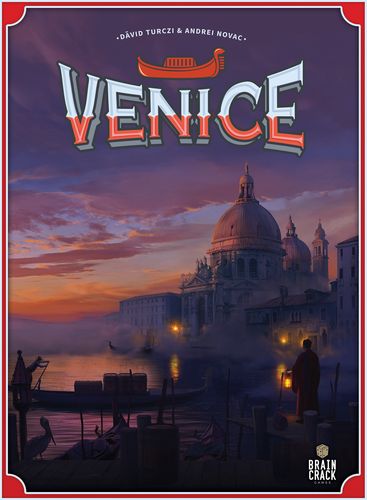
Gameplay Overview
This is a general overview to provide context for the review, not an in-depth how to play. Some rules are glossed over or missing.
Venice the game uses travel by gondola through the famous canals of its namesake city. Players act as “merchants” using the canals to pick up various resource cubes and deliver them to specific buildings in order to complete mission cards in their hands and gain political sway. But with great power comes great gossip – careful of accumulating intrigue on your road (canal) to success.
Game Flow
In Venice, players take turns carrying out actions. Game length depends on reaching one of two possible end game triggers, so the pace of the game can change depending on the player count and how the players typically play. When it’s just the two of us, we tend to draw games out to maximize point scoring (usually unconsciously).

Setup
The variable setup in Venice is really impactful:
- Buildings on Central board – place randomly so that the location of buildings on the canals is different each game
- Mission cards – deal the correct number of cards from the deck for the player count so that each game has different missions available
Pregame:
- Players place one gondola on the board in turn order, then place the second in reverse turn order (last player places 2 in a row)
- When placing, players also place an assistant and activate that building following normal rules (see below)
Actions
Play Influence Card
Players choose one influence card from their hand and play it, following instructions on the card. Influence cards have a lot of possible effects, from gaining additional points to movement advantages.
Move Gondola
After playing Intrigue cards, players move their gondolas along canals any number of spaces following the movement and interaction rules.
- If you stopped at a building that already has gondolas at it, give the existing gondolas points according to how many are behind it Ex. if you stop at a building with 2 gondolas moored, the first gondola gets 2 points, the second gets 1, and you get 0
- At the beginning of the movement, choose where to put the gondolier
- Free to move the gondolier to the opposite gondola as last turn
- 3 coins to keep gondolier where they are
- Only move the gondola with the gondolier
- The first movement of each turn is free
- Subsequent movements cost the amount depicted on that canal
- Never move along a canal you’ve already been through that turn
- Never move past a building you’ve already been to that turn, even if you don’t activate it. This includes the start building
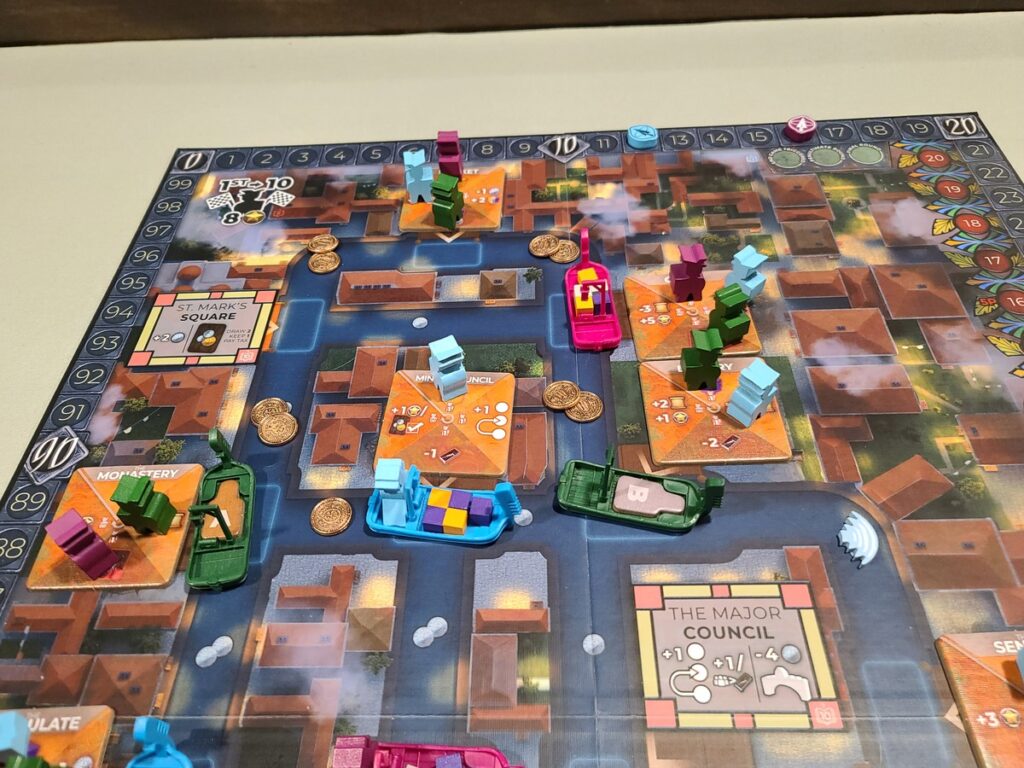
- If you meet another gondola (including your own), stop and carry out a meeting
- Own gondola: optionally pass cargo between the two gondolas
- Another player’s gondola: choose to either lose a scroll or gain an intrigue
- At each building, players may optionally pause to activate their assistant, if present
- Repeat above until you want to remain (“moor”) at a building
Pro Tip: The rulebook recommends you leave coins on the board showing where you’ve traveled. This is CRITICAL because it’s shockingly hard to remember. Late game turns can have a TON going on from moving more and activating more buildings, and it’s hard to remember where you’ve been.

Mooring - Stop at a Building
Eventually, you’ll run out of coins or arrive at your destination. Then you stop, announce that you’re mooring (as opposed to pausing) and complete your turn:
- Play mission card that matches that building
- Pay for it using resources from your gondola at the building (+scrolls if necessary)
- Collect points + coin reward
- Place the card under your player mat with ongoing effects displayed
- Only 3 mission cards may be displayed under the mat for ongoing effects, but players may continue completing missions for the points/coins and choosing to either cover up previous effects, or tuck the recent effect under ongoing effects
Pro Tip: The bonuses for missions cards are huge, and the ongoing effects can be powerful when incorporated into your strategy. We’ve found that players who don’t complete as many mission cards in a game almost certainly will lose, so don’t fall behind!
- Advance Assistant
- Each building has 4 spaces that assistants move around clockwise
- Move your assistant into the next space on that building
- If you don’t have an assistant on the building, add one to the top
- If another player is already in the space you’re moving to bump them forward (except the 4th/final spot, which can hold unlimited assistants)
- If you’re already in the 4th/final spot, stay there
- Activate Building
- Perform the entirety of any/all of the spaces up to and including where your assistant is located. Ex. if your assistant is on the second space, perform the second and/or first space actions
- If you can’t perform the entire action, you can’t use that space
- Do this in any order Ex. space 1, then 3, then 2
Concept: Intrigue & Scrolls
Throughout the game you’ll gain and lose intrigue and scrolls from various buildings and cards. At the end of the game, if a player has the most intrigue (not zero), they automatically lose. In game, intrigue can also result in negative points if players earn too much of it. So it has serious consequences if you let it get out of control. On the flip side, taking intrigue can often get big rewards like influence cards or allow you to pass another player to get where you need to go faster/cheaper.
Pro Tip: Intrigue = bad, but don’t be afraid to take it. Often you gain intrigue as trade off for something great, like an influence card on certain buildings. You WILL gain intrigue, so don’t shy away from it, just make a plan to get rid of it by placing assistants at buildings like the Church.
During meetings with other players’ gondolas, you can lose a scroll instead of taking intrigue. Scrolls can also be traded for points at certain buildings.
Concept: Bridges
Players can place bridges to avoid paying the canal fee for the rest of the game. These are clutch, because other players can pass for free, but they gain an intrigue. You gain a coin when using your own bridge.
Pro Tip: try to find a good location for your bridge to not have to pay as much, but also somewhere your opponent consistently needs to go. The intrigue can really add up for them, so you can use bridges to throw a wrench in their strategy.
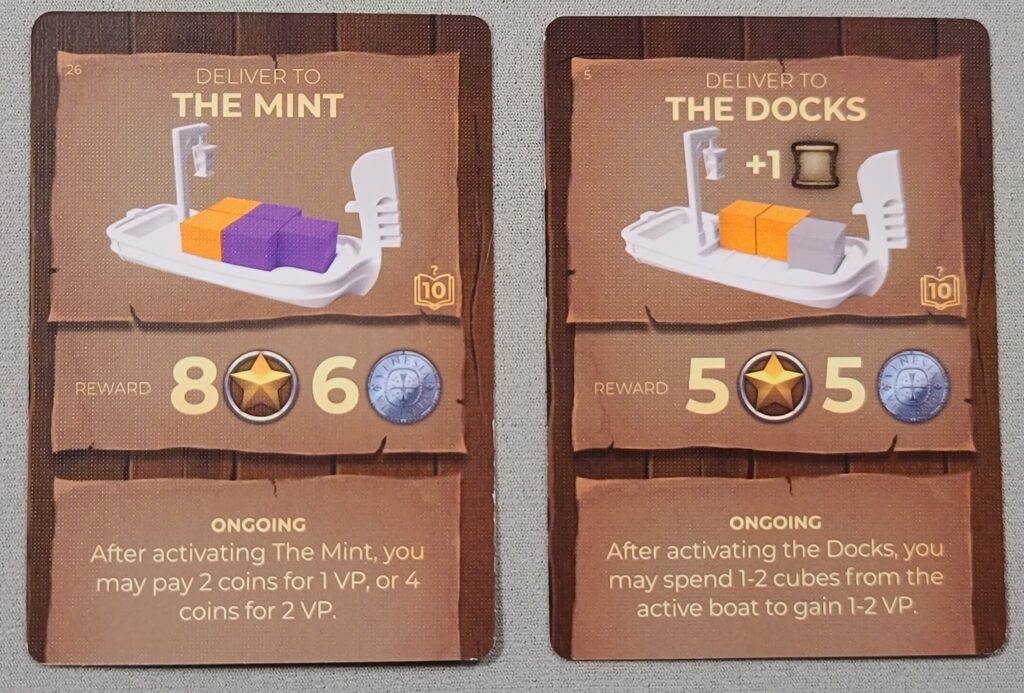
Game End
The game end is triggered 2 ways:
- Major Council: A player marker reached the Major Council Marker on the Major Council Track
- Players can move up the major council track by visiting specific buildings
- The Major Council marker is placed on a number according to the number of players – lower for fewer players
- Mission Card Deck runs out:
- The last Mission Card is taken from the deck
- Like the major council track, the number of cards in the deck varies by player count
Once game end is triggered, play continues through the last player so everyone has a equal number of turns. Play continues for 2 more rounds (each player gets 2 more turns), then score.
Scoring
- Score Major Council points based on order on the track and player count
- Score based on how many assistants you were able to assign to buildings
- Adjust intrigue track: notice that getting rid of intrigue at the end of the game is WAY more expensive than in-game methods
- 2 scrolls = -1 intrigue
- 4 coins = -1 intrigue
- Player with the most intrigue loses automatically
- 4 coins = 1 point
Pro Tip: In the 2-player game, most of our points are from in-game scoring based on buildings, missions, and some intrigue cards. Don’t always count on end game scoring to save you if you fall way behind.
Variants
- Solo Mode
- 2-Player Mode: Smuggler
- Ghost or robot “3rd” player adds tension to the 2 player game by increasing the number of meetings & assistants on buildings
- Both players have some control over the smuggler ships – each have a smuggler deck (A or B) that has a card for each building
- At the end of their turn, players draw 2 cards from their deck, choose one, and move their smuggler ship (A or B) the cheapest route to that buildings, following the normal meeting rules
What do we think?
We approached this game with equal parts skepticism and excitement. Venice is the second game in the Eurocity Trilogy by Braincrack Games, and we really enjoyed the first game – Ragusa. It’s also a collaboration by two prolific designers: Andrei Novac and Dávid Turczi, who consistently put out great games.
We were skeptical about how it would play at 2-player, since pick up and deliver games usually rely a lot on direct competition and interaction to be fun. However, we were pleasantly surprised! Venice managed to work well at 2, which is a huge bonus during a global pandemic for those itching to play a pick up and deliver game, but unable to get a big enough group together.
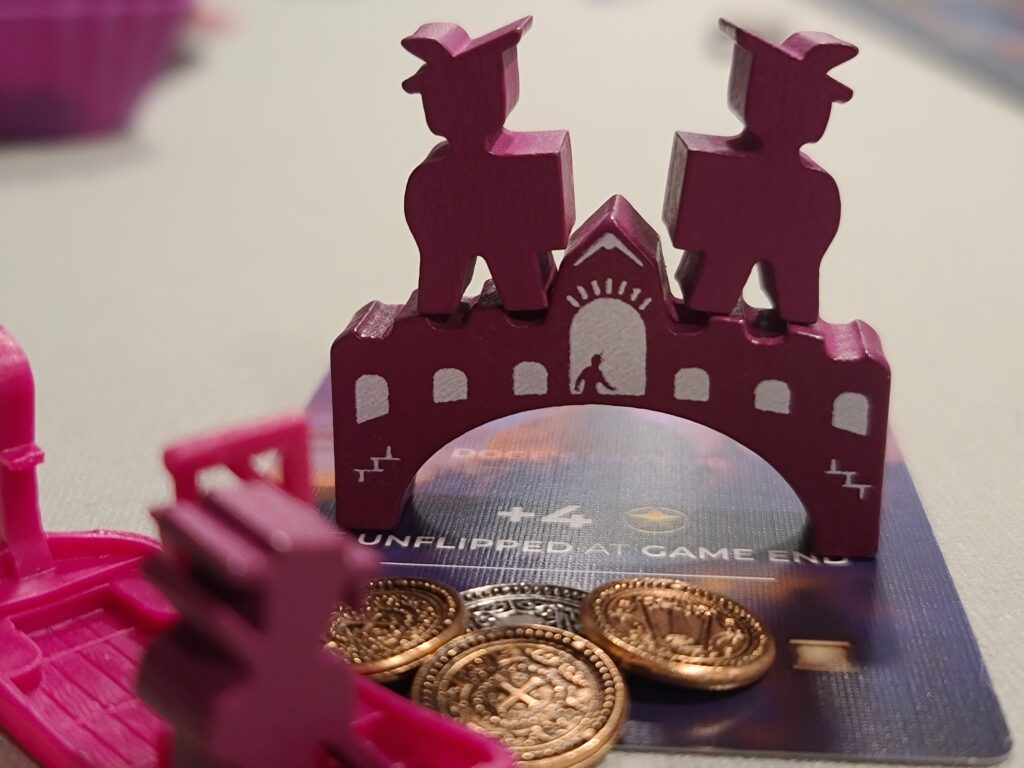
What did we like?
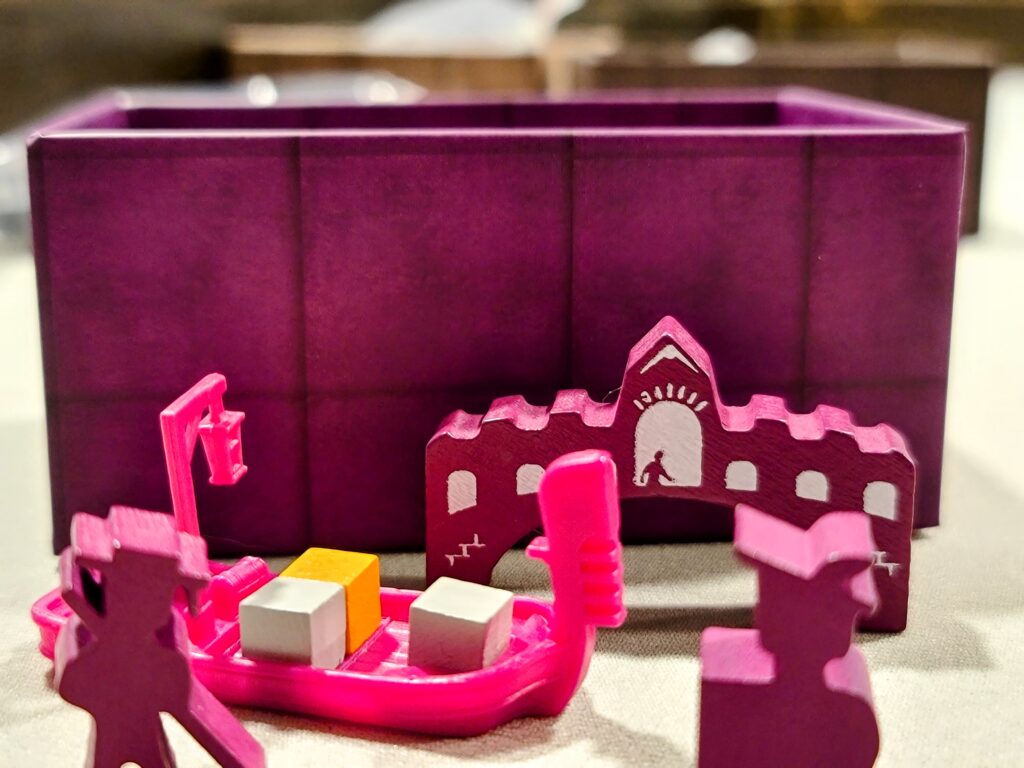
If you’ve been following our reviews, you know that we are big fans of engine building games. While Venice is not technically an engine building game, it certainly feels like one. By mid-game you have 5-7 of your Assistants out and start can making epic paths through the canals, activating multiple buildings as you pass by. We’ve both experienced over several games the satisfaction of making a round over a huge portion of the board in an epic turn. It’s so satisfying and rewarding. David Turczi, in a BGG post, describes it as “short term engine building” which is completely fitting.
The bonuses from influence cards and completing mission cards also make each game feel unique. You have to be able to adapt your strategy to what you get in order to get the most bang for your buck. It keeps the game dynamic and engaging so that you’re always considering and re-considering your next few moves.
We did like the smuggler 2-player mode. The ghost player does a fairly good job of making gameplay tight enough that the mechanisms work. Without the smuggler, this game wouldn’t be much fun at 2-player so it’s a necessary addition. The biggest drawback is that it makes it almost impossible to get the “first to 10” bonus for the player who gets all their assistants out first, since the smuggler is also putting out assistants. In essence, the smuggler has 2 turns per round (“A” boat after player 1, “B” boat after player 2), and so has twice as many opportunities to get assistants out. Your opponent would essentially have to not pay attention to you at all, or would have to have extremely bad luck when drawing their location cards. In the grand scheme of things, 8 points is not that much so not a huge deal.
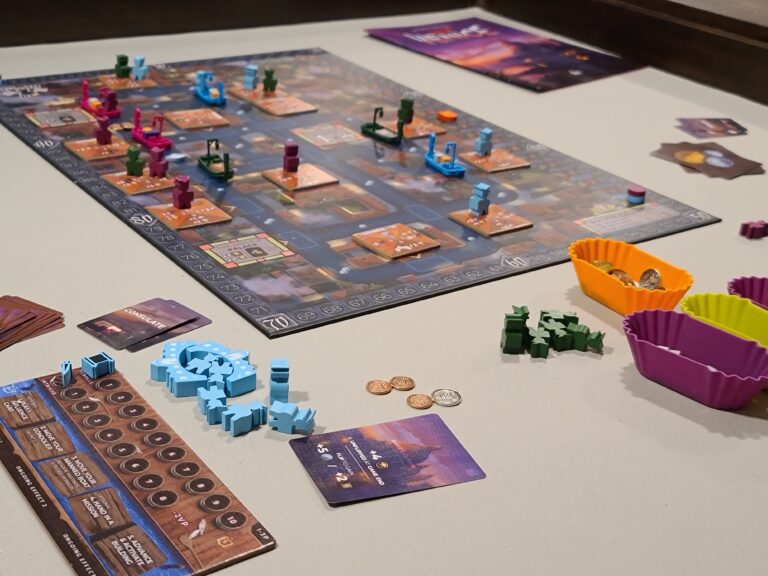
What didn't we like?
We’ve have similar complaints to other reviewers we’ve seen and most of it is related to finicky aspects of the design. The board needs to be bigger – at 2 players (with the Smuggler “3rd” player), it’s really crowded and the pieces don’t fit nicely. There also isn’t room for all the assistants on the buildings and the iconography telling you what actions to take at each building get easily blocked/covered up. The iconography also isn’t the greatest, sometimes it’s confusing when to increase or reduce the scrolls or intrigue.
It’s also a minor point – but as cool as the little gondola pieces are (and they are pretty cool) we knock the gondolier out CONSTANTLY. Any time we touch the gondola, something falls out of it. It gets to be really annoying, especially when you’re playing with the Smuggler so you’re in essence moving gondolas twice as much as you normally would.
We also found ourselves having to go to forums in BGG for rule clarifications or things that we missed in the rulebook more than we normally have to for games in this weight class. Once we got clarification, however, actual gameplay itself is straightforward and subsequent games were just fine.
Who will like this game?
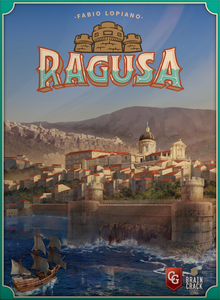
Venice is the second game of the Eurocity Trilogy from Braincrack Games. Fans of Venice will definitely want to check out the first game, Ragusa, as well as the upcoming Florence. While each game is unique in design and mechanisms there are threads that tie the games together.
If you enjoy games with mechanisms of contract fulfillment, pick up and deliver, and games with route building, you’ll definitely want to check out Venice. And as we mentioned, we wouldn’t call Venice an engine building game, per se, but it gives that feeling multiple times throughout the game.
Sarah's Take
I have been pretty excited for Venice since the Kickstarter ran last year; a pick up and deliver game designed by David Turczi sounded incredible to me! And the middle few turns of Venice give me exactly the feels I hoped for from the game. But the slow start kinda brings it down a bit for me. You really want to spend your first few turns either setting yourself up to quickly be able to advance assistants and get a money “engine” going as soon as possible, or you want to try to quickly gather the resources needed to complete your first mission and get that ongoing ability quickly to guide your strategy through the rest of the game.
Is that much different from other games though? No. But it somehow feels different for me. Like it is more work to get going. I really want to experience Venice at 3 or 4 players because I think that extra boost of players and interaction would speed up the beginning of the game a good bit.
I also think there’s probably an “us” issue in the beginning as well. Emily and I are both conflict avoidant players and we especially avoid helping each other out early on. If we sucked it up and either accepted that we would be giving the other a point or two (honestly not a huge deal overall) or were be more willing to go hard early on taking more intrigue I think that “slow start” would probably shrink back.
One thing I think that really amps up the fun factor for me are the influence cards. They can be powerful one time bonuses that when used at the right time are hugely impactful and make you feel like a boss with an epic turn.
Emily's Take
I really like pick up and deliver games, since they’re usually really rewarding from seeing your plans play out in the short and long term.
Sarah and I both have a weakness with Venice, however, and that’s both of our desire to milk a game for as many points as possible. What that means in Venice is that we both get lost in what’s happening on the board (creating an incredibly rewarding path of mega points) and forget to actually advance the end game triggers, both of which you must go out of your way to do. We have had games of Venice that last >2 hrs, which for a mid-weight game is a bit of a drag by the end. Both end game triggers (moving up the Major Council track or drawing Mission cards) mostly require you to end your movement at a building that really only lets you do that one thing. And trust me, there is always something else that seems like a better idea.
We figured out pretty quick that in a 2-player game the Major Council track is sort of a bust. It takes too much work, which means you’re sacrificing doing other point scoring (and frankly, more fun) things so that you can mostly move up one painful step at a time. I don’t think that would be true of 3+ player games, since there are ways to bump up the track faster depending on other players’ intrigue.
Mission cards are where it’s at to make sure the game doesn’t drag on for 2-player. It’s much more fun to incorporate them into your strategy and they really capitalize on the pick up and deliver mechanism.
Breakdown
Rulebook / Learning the game
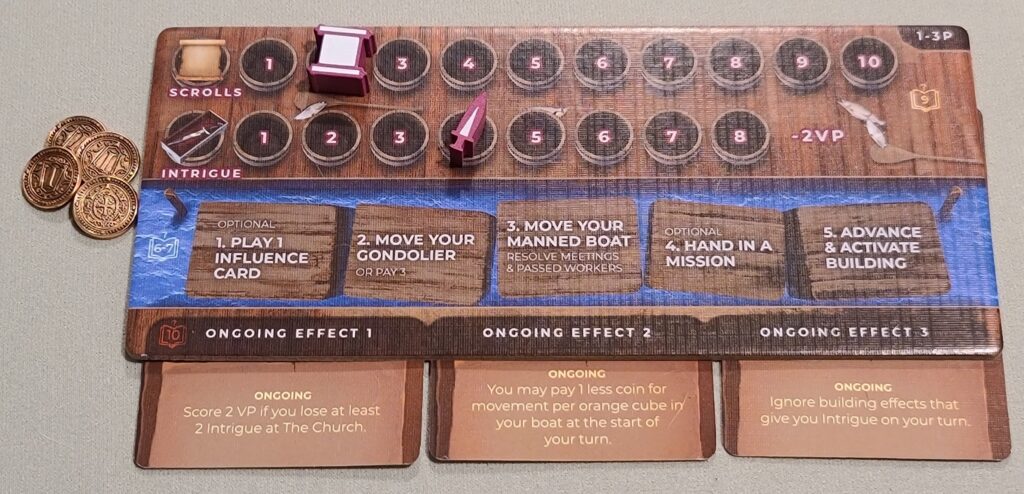
The rulebook for Venice is laid out first with an overview of a players turn and then later goes into detail about each aspect of the game. This works fine and is especially helpful if you teach games from the rulebook or need a quick refresher between plays.
There were a couple of things that were unclear to us when initially reading the rules, but both Braincrack and David Turczi are active on BGG clarifying any rules questions for players. There is also this helpful thread (https://boardgamegeek.com/thread/2621334/check-you-play-5-most-important-rules-venice) that is worth read before jumping into Venice.
First Play
Our first play of Venice was pretty slow. We needed the full playthrough to really understand how the buildings interacted together and how to chain the building activations by passing them. The iconography wasn’t very intuitive for the first play and we found ourselves consulting the rulebook frequently during the first play. This wasn’t too much of an issue after the first game though.
Subsequent Plays
We definitely found our groove with additional plays of Venice. Did the game get faster for us? No. We still get hung up on running those fun little mini engines. As we played more we definitely learned how to manage our intrigue and which buildings comboed well together.
Parent Perspective
Interruptions
Interruptions are a little bit tricky in Venice. Some people will be just fine experiencing interruptions but others may not. By mid to late game player turn lengths increase. Depending on how much money a player has, they can activate anywhere from 5-7 buildings on a turn. This can take a bit to resolve. However, as the player passes opposing players, both players must either take Intrigue or use a Scroll.
We were just fine either taking a tally of how many interactions there were, or even just adjusting each other’s player boards. We fully recognize that not everyone likes their bits messed with though. Those that want to watch everything happen may struggle with interruptions in Venice.
Time Investment
Fun fact about us: we are slow players. Not slow in that we experience a ton of Analysis Paralysis (cough, Emily), but rather that once we figured out how to chain the buildings together and run little mini engines, we couldn’t get enough of it and probably kept the game going longer than necessary.
A two player game of Venice comes it right at about 2 hours for us. Clean up and set up times are fairly minimal, so almost all of the time is spent playing the game.
Life Fit
Venice is likely to be a weekend only game for us since it takes a bit longer than we’d like to play on a weeknight. This may not be the case for others who are much better at ending the game in a reasonable amount of time (okay, but just let me hit all those sweet, sweet buildings one more time).
Rating
6.5/10
Overall Venice is a solid game and gets big props for making pick up and deliver work for two players. Our ratings are based on how often we’d bring this to the table over similar games. Comparing to the first in the series, we liked Ragusa a bit more. Venice would likely work a bit better at 3+ players, but it does do a great job modifying for 2 players, especially for a pick up and deliver game.
*See our rating scale HERE
Click through for more posts, or follow us on social media to see what we’re playing and for new post updates!

Pingback: Board Game Review: Florence — The Top Mag